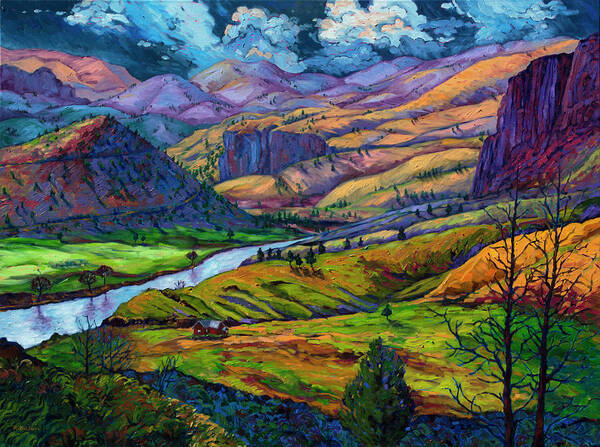John Day Country
There the spirit may sing its making,
and the pilgrim wander the wind-kissed ridges
to commune with hawks in the high desert.
There I would go to get heart’s ease.
I would shelter with cougars in the shadowy pines.
I would sing with coyotes in a star-scarred sky.
I would chant with the rapids roiling through the canyons.
I would den with the bear and dance with the deer.
I would run with the rabbits through the sage and the sand
I would untwist the tangle of my terrors
and walk a free man on the wind’s highways.
There I would live, lonely and clean,
where the air’s so thin the eagle falters.
There I would sing my spirit song

John Day River Country -- Rebecca Baldwin
There the spirit may sing its making,
and the pilgrim wander the wind-kissed ridges
to commune with hawks in the high desert.
There I would go to get heart’s ease.
I would shelter with cougars in the shadowy pines.
I would sing with coyotes in a star-scarred sky.
I would chant with the rapids roiling through the canyons.
I would den with the bear and dance with the deer.
I would run with the rabbits through the sage and the sand
I would untwist the tangle of my terrors
and walk a free man on the wind’s highways.
There I would live, lonely and clean,
where the air’s so thin the eagle falters.
There I would sing my spirit song

John Day River Country -- Rebecca Baldwin
By the time he was about 27 John Day had traveled from his native Virginia through Kentucky to Spanish Upper Louisiana (Missouri) and in 1810, when he was 40, he joined Wilson Price Hunt's expedition to explore the Pacific coast for John Jacob ASstor's Pacific Fur Company. Hunt had difficulty recruiting, since most of the available men were "drinking in the morning, drunk at noon and dead drunk at night," according to historian Marcus Petersen. They left Nodaway, Missouri, in April 1811. When the party encountered the Snake river, they abandoned their horses and attempted to travel downstream, but after 9 days they reconsidered their plan after losing a man and 2 canoes in the rapids; they divided into 4 parties that took different routes to the Columbia river and arrived at the recently constructed Fort Astoria in February 1812. En route, Day was robbed and stripped naked by natives near the mouth of the John Day river. Ft. Astoria (at Astor, Oregon, in Clatsop county) had been founded in May 1811 by a party that had arrived by ship via Cape Horn: The "Tonquin," under the command of US Navy lieutenant Jonathan Thorn; in June 1812 Thorn sailed for Vancouver island to trade with the Nuu-chah-nulth but provoked a quarrel with them, leading to the destruction of the ship and the loss of the entire crew. As a result Robert Stuart led an overland expedition back east to report to Astor, blazing almost the entire segment of the Oregon Trail between the Columbia and the Missouri river. Day had initially been part of the expedition but was left on the Lower Columbia river and went mad. He spent the next 8 years hunting and trapping and died in 1820 near the Little Lost River in Butte county, Idaho, where Donald MacKenzie of the British North west Company had established his winter camp. The Little Lost river was known as Day's river for a time and its valley was Day's Defile. Today his name is attached to the John Day river and its 4 branches in eastern Oregon, the cities of John Day and Dayville in Grant County, OR, and a smaller John Day river and an unincorporated community in Clatsop county, as well as the John Day dam on the Columbia and the John Day Fossil Beds national monument.
ReplyDelete